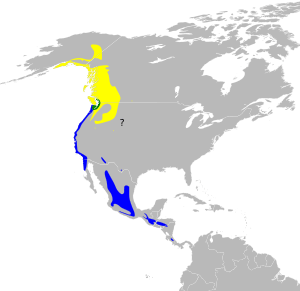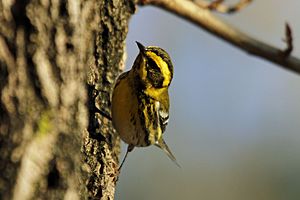Townsend's warbler facts for kids
Quick facts for kids Townsend's warbler |
|
|---|---|
 |
|
| Conservation status | |
| Scientific classification | |
| Genus: |
Setophaga
|
| Species: |
townsendi
|
 |
|
| Range of S. townsendi Breeding range Year-round range Wintering range | |
| Synonyms | |
|
Sylvia townsendi (protonym) |
|
The Townsend's warbler (scientific name: Setophaga townsendi) is a small, colorful songbird. It belongs to a group of birds called New World warblers, which are known for their beautiful songs and bright feathers.
Contents
About Its Name
Birds and other living things have scientific names. This helps scientists around the world know exactly which creature they are talking about.
The Townsend's warbler was first officially described in 1837. An American naturalist named John Kirk Townsend gave it the scientific name Sylvia townsendi.
Later, this warbler was placed in the genus Setophaga. This group was created by an English naturalist, William Swainson, in 1827.
This bird is considered "monotypic." This means there are no different types or subspecies of the Townsend's warbler.
What It Looks Like
The Townsend's warbler is a striking bird with bright colors. It has a yellow face with a black stripe that goes across its cheeks. This stripe extends into a dark patch near its ear.
Its beak is thin and pointed, perfect for catching insects. It has two white bars on its wings. The feathers on its upper body are olive green with black streaks on its back and sides. Its belly is white.
Adult male Townsend's warblers have a black cap on their head and a black throat. Their lower chest is bright yellow.
Female warblers have a dark cap, but their throat is yellow. Young birds look similar to females, but their cap and cheeks are a darker green.
| Standard Measurements | |
|---|---|
| Length | 4.5–5 in (110–130 mm) |
| Weight | 8.8 g (0.31 oz) |
| Wingspan | 8 in (200 mm) |
| Wing | 63.1–69.9 mm (2.48–2.75 in) |
| Tail | 47.1–54 mm (1.85–2.13 in) |
| Culmen | 9.9–10.8 mm (0.39–0.43 in) |
| Tarsus | 18.1–19 mm (0.71–0.75 in) |
Life and Habits
Townsend's warblers build their nests in coniferous forests. These are forests with trees like pine, fir, and spruce. They prefer large trees along the northwestern coast of North America.
Their nests are shaped like shallow cups. They build them using grass and line them with soft moss. These nests are usually placed on top of a branch in a conifer tree.
The female warbler lays 4 to 5 eggs. The eggs are white with brown speckles.
This bird is closely related to the hermit warbler. Sometimes, these two species will breed together where their living areas overlap.
Migration and Diet
Some Townsend's warblers from Haida Gwaii (an archipelago off the coast of British Columbia) travel short distances south along the Pacific coast.
Other warblers fly much further for winter. They spend the colder months in Mexico, Central America, and the southwestern United States.
These birds are very active when they look for food. They search in the higher branches of trees. Sometimes, they hover in the air or catch insects while flying.
Their main diet includes insects and spiders. They also eat seeds. When it's not nesting season, these birds often look for food in mixed groups with other bird species. In winter, they also enjoy eating berries and plant nectar.
Sounds and Calls
The male Townsend's warbler has a distinctive song. It sounds like a buzzed zee-zee-zee-bzz-zee. This song is a bit similar to that of its relative, the black-throated green warbler, which lives in eastern North America.
When they make a call, it's a sharp tup sound.
See also
 In Spanish: Reinita de Townsend para niños
In Spanish: Reinita de Townsend para niños



